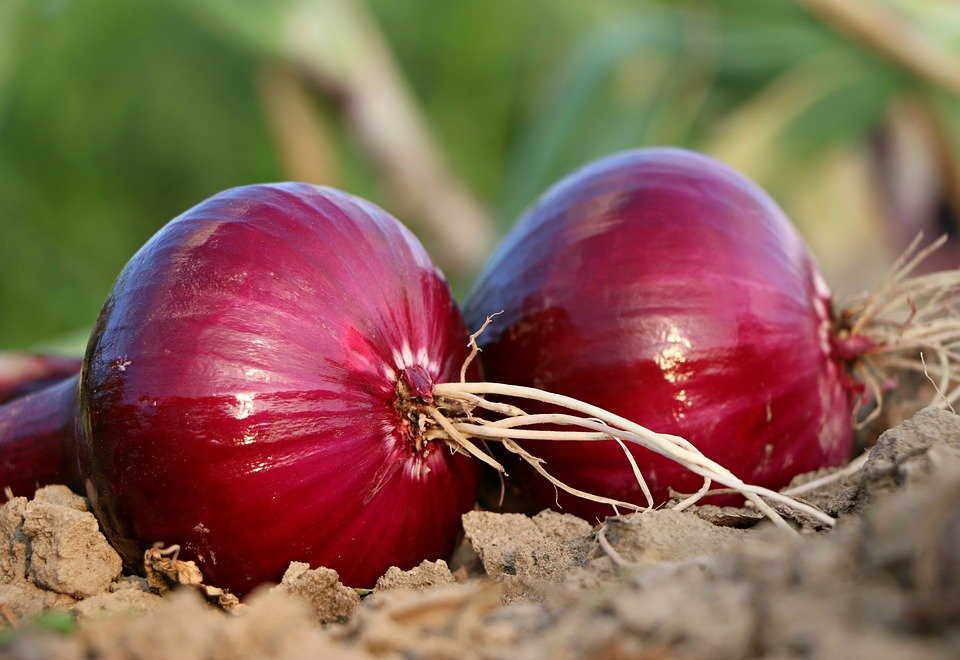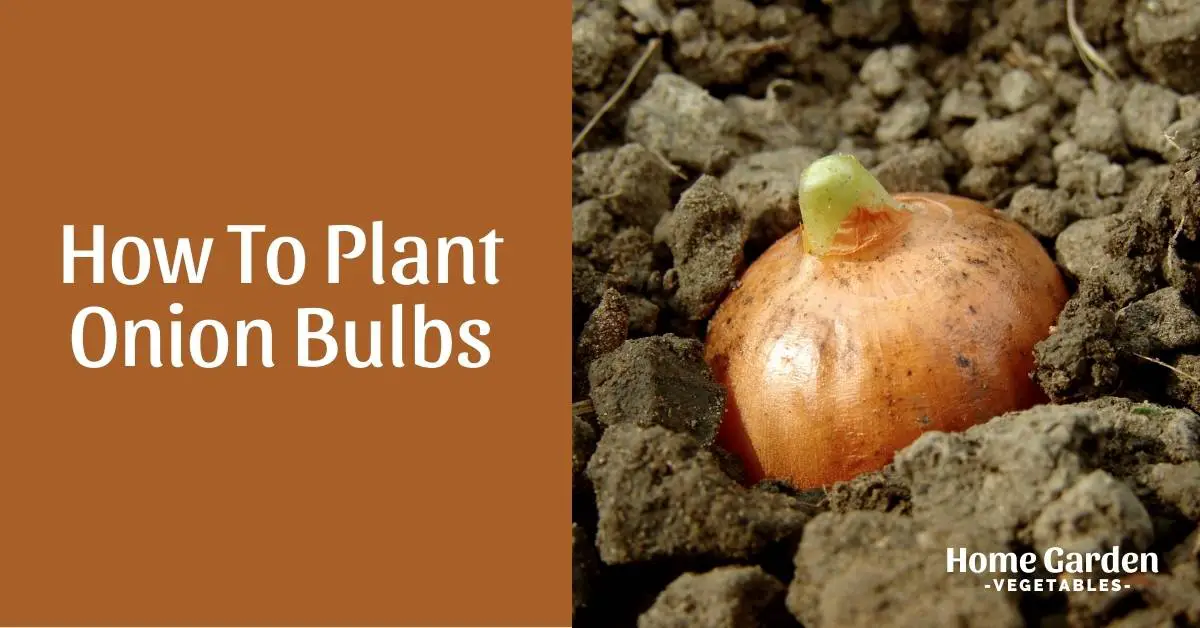Onions are hardy cold-season crops, easy to grow at home to harvest endless batches of fresh onions from around midsummers. Though they’re not too expensive to buy from the store, the flavors, nutrients, and satisfaction you get from using homegrown onions are incomparable. People are always asking me how to plant onion bulbs. Here is my advice acquired over the last 5 years of successful onion growing.
In most climates, you can plant onions twice a year – the first crop can go in the soil as soon as it’s workable at the start of spring, followed by a second crop in the fall. If you’re a patient gardener, growing from seeds is a good and cheaper option. However, if you’re looking for faster results, grow from onion sets.
Reader Poll: What online courses would interest you?

Should You Plant From Seeds Or Sets?
Some gardeners like to start from scratch with onion seeds. They save seeds each season to plant them next year and continue growing onions year after year without any investment. However, since onion seeds take much longer to establish, a faster alternative is to plant onion sets. Onion sets are immature onion bulbs. They are simply small onion bulbs that did not grow to their true size in the previous growing season.
Are Supermarket Onions A Good Option To Start A Crop?
You must already have onions in the kitchen. Planting some of these store-bought onions may seem like an attractive option since it will save you a trip to the nursery. However, these aren’t a preferred choice of gardeners since they’re often treated with chemicals for better storage before being put up for sale. These chemicals make supermarket onion bulbs unsuitable for replanting.
The better option is to grow onions in your home garden using onion sets or onion seeds available at the nursery. Since they’re carefully bred for being planted, they’ll grow faster, producing successful results with little effort.
Subscribe to our newsletter!
How To Choose Varieties For Your Region?
Not every onion variety will necessarily thrive in your garden. Different types of onions have different climatic requirements, so it’s important to choose a type that will suit your climate. In onions, the formation of bulbs is triggered by the length of summer daylight hours.
With the number of daylight hours required by the different cultivars, onion varieties are classified into three groups:
Long-day onions
Long-day onions require at least 15 hours of summer daylight hours each day to grow mature bulbs.
Short-day onions
Short-day onions require about 12 to 13 hours of daylight hours each day in the summers to grow big bulbs.
Day-neutral onions
Day-neutral onions, or intermediate day onions, aren’t affected by the daylight hours.
If you live somewhere in the Pacific Northwest and Northeast regions of the US and Canada, long-day onions are best for growing in your garden. If you live somewhere in the southern regions of the US, choose short-day varieties. If you’re confused and still can’t figure out what will work for your climate, you can skip the trouble and go for one of the day-neutral varieties.
Best Onion Bulb Varieties

There are several different varieties you can grow from seeds or from sets. They differ in their shapes, color, and flavors. Some are better suited for storage, while some are best consumed fresh. Some varieties are preferred for their green tops – green onions. Other than flavor and storage preferences, you’ll also need to consider the climate you live in. find varieties that are well-suited to your region so that they can thrive with little effort.
Some Good Varieties Of Onion Bulbs For UK
- Autumn Champion
- Centurion F1
- Egyptian Walking Onions
- Electric
- Hytech F1
- Radar
- Red Arrow
- Red Baron
- Red Ray
- Santero F1
- Senshyu Yellow
- Setton F1
- Snowball
- Stuttgarter
- Sturon
Some Good Varieties Of Onion Bulbs For the US
- Red Onion
- White Onion
- Stuttgarter Reisen Onion
- Sturon Onion
- Yellow Onion
- Red Sun Shallot
- Candy Super Sweet
When To Plant Onion Sets?

Now that you’ve picked your favorite varieties to plant, you’ll need to wait for the right time to set them in the ground and initiate the growing season. Timing your growing season is very important if you want to grow big, flavorful onions.
Onions are photothermoperiodic. It may seem like a complicated term to use for an onion, but it simply means that onions require some specific hours of daylight along with an ideal temperature to grow their best. This is exactly why we need to set them in the ground on time to achieve those requirements. Long-day onions (such as red, yellow, and white onions) will especially need to be planted early in spring so they can receive 13 to 16 hours of sunlight for bulb formation by summertime.
Spring Planting
You can plant two crops each year, one in the spring and another one in the fall season. For the spring crop, plant onion sets in the ground as soon as the soil can be worked in spring. The goal is to plant onion sets outdoors while the weather is still cool but not too cold. Plant onion bulbs when the outdoor temperatures remain consistently above 28°F, usually around March or April.
Fall / Autumn Planting
A fall crop shouldn’t be missed either since it results in larger and more flavorful onions than spring planting. This is because they can benefit from a longer growing season, with a period of winter dormancy for the better development of bulbs.
For a fall planting, plant onion sets in the ground while the weather is still warm in autumn, so they can have 4 to 6 weeks of warm weather to establish a strong root system before the onset of winters. The plants go dormant during the winters and will resume growth in early spring as soon as the temperatures start rising.
Where To Plant Onions
Next up, you need to choose a good site to plant onions. Choose a spot with full sun exposure, where your onions won’t be shaded by walls, trees, or surrounding plants. Remember that they need several daylight hours each day to grow big bulbs, so make sure they can get that.
Good soil is just as important. If you live in a region with clayey or hard soil, consider growing onions in a raised bed since they thrive in loose, fertile, well-drained soil. Alternatively, you can add plenty of aged compost to improve the texture of your garden soil. Loosen the soil, tilling it to a depth of 8 to 10 inches, so it’s not too compacted for the bulbs to grow bigger.
Amend the soil with aged compost and other organic material in the fall before planting. Add another inch of compost along the rows before planting the onion sets. Other than these amendments that you make before planting, your onions feed heavily and will require regular fertilization for optimal bulb development.
Remember to practice crop rotation. Don’t plant onions in the same garden bed where you plant onions last year since it promotes diseases.
How To Plant Onion Sets
You can grow onions from seeds, sets, or bare-root transplants available from retailers in winters and early spring. Of the three techniques, growing from onion sets is the fastest and the easiest. Follow the procedure below to grow an onion garden from onion sets!
Choosing Sets
As pointed out earlier, onions bought from the grocery store aren’t a good option for growing. Either order sets from online gardening retailers or a local nursery since they’ll produce excellent results even with little effort.
When planting from sets, choose onion bulbs that are no bigger than ¾ inches in diameter. Larger onions aren’t a good choice since they quickly go to seed. Since one little onion bulb will grow into one big onion, you’ll need to plant as many onion sets as you want to harvest.
Planting Sets
Dig a hole in the ground that’s about 2 inches deep. Plant the sets in the hole with the root end facing down and the tip facing upwards. Cover the tips of the sets with an inch of soil, but not more. If you plant too deeply, it will again affect bulb development. Water generously immediately after planting.
Spacing
Space onions 4 to 6 inches apart in rows, maintaining a distance of 12 to 16 inches between rows. This will allow plenty of space for the bulbs to grow bigger. If you’re planting green onions, you can plant onions closer together, leaving at least 2 inches between the sets.
Companion Planting
Since most urban gardeners are short on growing space, they try to squeeze in different kinds of crops in the same garden. While it’s a good space-saving technique, you should know which vegetables are good for being planted next to each other and which ones aren’t. Take a look at the lists below to see which vegetables work well when planted next to onions and which ones don’t.
Good Companions For Onions
Here are some of the good companions for onions:
- Cabbage
- Broccoli
- Tomatoes
- Brussels sprout
- Parsnips
- Spinach
- Kale
- Celery
- Beets
- Pepper
- Carrots
- Strawberries
- Bad Companions For Onions
Here’s a list of plants you should avoid planting near your onions:
- Sage
- Asparagus
- Beans
- Peas
Tips For Growing Bigger Onions

Your work isn’t over once the onion sets are underground. You still need to take care of some things as your onions start growing if you want to ascertain a hefty, flavorful harvest. Follow the tips to grow the biggest onions:
Keep Out The Weeds
Since onions have shallow roots, they don’t hold up a good competition against weeds. Pull weeds as soon as they appear, especially for the first couple of weeks after planting the sets since the onions will need all the nourishment they can get to establish a healthy crop.
Spread a 1-inch layer of organic mulch, such as straw, dry grass clippings, or shredded leaves, around the plants to keep the weeds at bay. Mulching will also help conserve soil moisture.
Watering Onions
Offer onions about an inch of water each week (including rainfall). Each time you water the onion plants, water deep enough to moisten at least 6 inches of soil depth. Regular watering is important to develop the sweet flavor of onions, so don’t let the onions dry out during the growing season.
At the same time, avoid overwatering too. Drowning the bulbs can water can promote root rot and diminish your harvest. To prevent root rot, cut back on watering as soon as the tops start turning yellow.
Fertilizing Onions
Onions are heavy feeders. Unlike other root vegetables, onions benefit from nitrogen-rich fertilizers (or all-purpose garden fertilizer) applied every few weeks as it helps develop bigger bulbs. However, stop fertilizing once the bulbs push out of the soil. This is the indication that the bulbing process has started.
Let The Onion Bulbs Emerge
Once the bulbing process starts, onion bulbs will push out of the soil and emerge above the ground. This is a natural process; bulbs need to emerge above the soil layer for proper development. Don’t push the bulbs back into the soil or cover the bulbs with dirt. Let them see the sun and develop bigger.
Conclusion
So now you know how to plant onion bulbs and grow some big, flavorful onions to spice up your meals. If everything goes well, the bulbs will be ready to harvest in about 3 to 4 months, once the tops dry and fall over. Make sure you’ve harvested the entire crop by late summers since the cool weather of the fall can spoil them. With the correct storage techniques, you can keep onions fresh through the winters and use them as needed in the kitchen.

